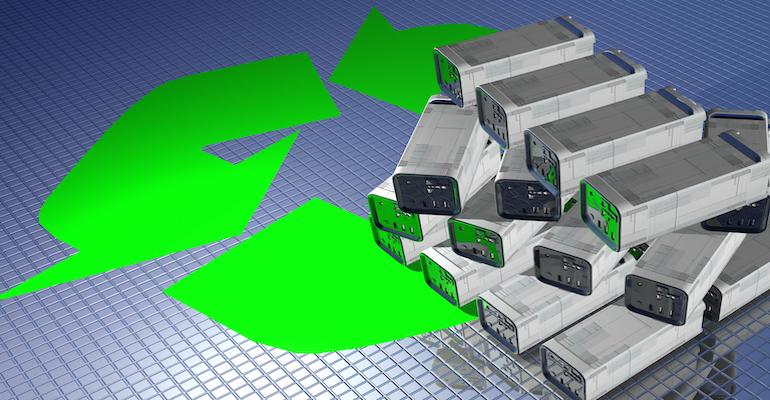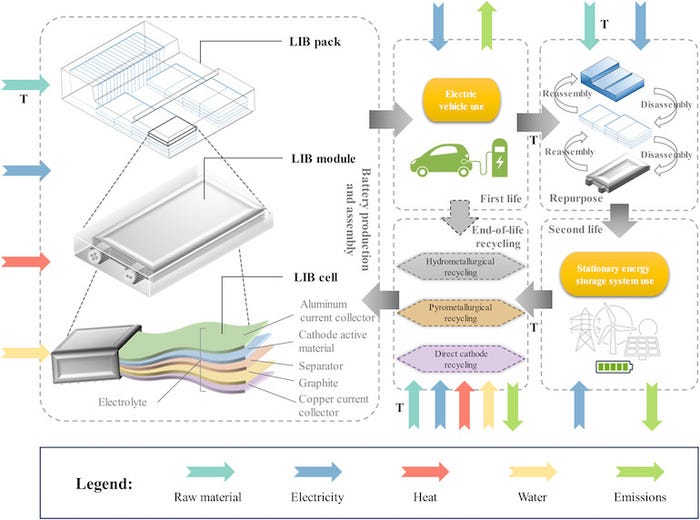Researchers at Cornell University examined economic and environmental trade-offs made in the life-cycle of current energy-storage devices for electric vehicles.
December 9, 2021

While many see electric vehicles (EVs) as a technology that can help solve the climate crisis, the batteries used in these automobiles—which currently contain toxic chemicals and thus have particular disposal requirements--have sustainability issues of their own.
This dilemma was the impetus for a recent study out of Cornell University that examined a number of ways to approach the problems associated with the waste created when the lifespan of an EV battery ends.
A team co-led by Fengqi You, a professor in energy systems engineering at the university, used advanced computer modeling to investigate environmental and economic trade-offs that exist in the complete lifecycle of EV batteries--from production to use to how they can ultimately be recycled and reused.
“What to do with all these retired electric vehicle batteries is going to be a huge issue,” You said in a press statement.
Today’s lithium-ion EV batteries are designed for performance and not for recycling or second life, he said. They typically last five to 12 years before they lose the energy capacity needed to power a vehicle. “There’s very little discussion right now about these environmental dimensions of improving battery design for recycling or reuse,” You said.
Understanding Trade-Offs
Researchers conducted a life-cycle analysis of EV batteries that considered a variety of options for battery materials and technologies, particularly regarding how economics are currently driving the decisions about how batteries are built.
One aspect of the research was to examine the use of cobalt, a common battery material, in this process. The team’s modeling demonstrated the trade-offs between both negative and positive aspects of its use in EV batteries, explained Lynden Archer, a dean of engineering at Cornell who co-led the study.
Cobalt is acquired through mining, which is labor- and energy-intensive as well as harmful to the environment. There also are ethical issues associated with cobalt mining in terms of the use of child labor and exploitation of workers in less-privileged areas of the world, he said.
This has led the material to be “conventionally thought of as undesirable in the low-cost batteries needed for an ‘electrify-everything’ future,” Archer explained.
However, cobalt has economic and material advantages for EV batteries, as its use in a cathode leads extends the lifespan of the battery and increases options for second-life use and materials recycling, he said.
These are the interests that must be balanced when considering the use of materials in EV batteries for a more sustainable future, researchers said.

Achieving a More Sustainable Lifecycle
The Cornell team’s analysis also found that the overall carbon footprint of an EV battery can be reduced by up to 17 percent if it can be reused before it is recycled, researchers said.
One way this can be done is to create power stations that store wind and solar energy, making use of retired EV batteries with reduced energy capacity, the study suggested.
Researchers also studied the current difficulty that recycling facilities have to break apart EV batteries to recover materials inside that can be reused. Specifically, the team considered the use of graphite as the anode-active material in EV batteries, which is difficult to recycle and emits carbon dioxide when it’s combusted.
One solution to this problem might be for policymakers to consider ways to incentivize recycling techniques that optimize the battery’s sustainability, noted Yanqiu Tao, a doctoral student at Cornell who also worked on the study. For instance, legislators could promote graphite separation or emerging recycling methods to reduce the environmental impact of the use of this material in batteries, he said.
The full study can be found published in the journal Science Advances.
Elizabeth Montalbano is a freelance writer who has written about technology and culture for more than 20 years. She has lived and worked as a professional journalist in Phoenix, San Francisco, and New York City. In her free time, she enjoys surfing, traveling, music, yoga, and cooking. She currently resides in a village on the southwest coast of Portugal.
About the Author(s)
You May Also Like





